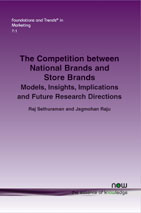The Competition between National Brands and Store Brands: Models, Insights, Implications, and Future Research Directions
By Raj Sethuraman, Marilyn and Leo Corrigan Endowed Professor and Chair of Marketing, Edwin L. Cox School of Business, Southern Methodist University, USA, rsethura@cox.smu.edu | Jagmohan Raju, Joseph J. Aresty Professor of Marketing, The Wharton School, University of Pennsylvania, USA, rajuj@wharton.upenn.edu
Abstract
In this article, we provide a comprehensive review of the literature on economic models of national brand — store brand competition and address three questions: (i) What types of economic models have been used to analyze the competition between national brands and store brands? (ii) What insights and implications have they generated? (iii) What are some useful future directions for modelers of national brand — store brand competition? We review 47 articles published or written during the period 1966–2011, present the model characteristics of the key articles, and develop over 160 results pertaining to national brand and store brand decisions. Then, we discuss the implications of these results and suggest directions for future research.
The Competition between National Brands and Store Brands
The Competition between National Brands and Store Brands provides a comprehensive review of the literature on economic models of national brand — store brand competition and addresses three relevant questions:
1. What types of economic models have been used to analyze the competition between national brands and store brands?
2. What insights and implications have they generated?
3. What are some useful directions for future research by modelers of national brand - store brand competition?
This monograph is an extension of earlier reviews on this topic with some important differences. The authors review 47 studies published between 1966 and 2011, and report over 160 results. More importantly however, the focus is exclusively on the analytical models that give rise to those results.
First, The Competition between National Brands and Store Brands presents a framework that is conducive for classifying the extant literature on national brand — store brand competition. Second, the authors compile pertinent articles and available working papers, and classify them using this framework. Third, the volume traces the development of the analytical models starting from the simple model with one national brand manufacturer and one retailer, and progressing to models with multiple manufacturers and retailers. Finally, the authors discuss the insights obtained from them and provide future research directions.
